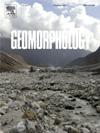浊流对复杂峡谷地形的流动和沉积响应:数值模拟视角
IF 3.1
2区 地球科学
Q2 GEOGRAPHY, PHYSICAL
引用次数: 0
摘要
海底峡谷是大陆边缘的显著特征,主要通过浊流作为沉积物迁移的主要通道。了解浊流如何与复杂的峡谷地形相互作用,对于解读峡谷系统演化至关重要,但由于实地观测有限,因此具有挑战性。本研究以南海北部珠江口盆地内的一组斜坡封闭峡谷为重点,整合了多波束测深、岩心分析和基于过程的计算流体动力学(CFD)建模,研究现实峡谷地形对浊流动力学和由此产生的沉积物沉积的影响。岩芯样本分析显示,潜在的浊积岩层以淤泥和砂质淤泥为特征。利用这些沉积物信息和测深数据,我们进行了一系列三维 CFD 模拟。我们的研究结果表明,峡谷群内的浊流特征,尤其是流速和沉积物浓度,存在很大的变化。这种可变性主要受峡谷水头深度、宽窄比和坡度梯度的控制。值得注意的是,模拟结果揭示了在实验环境中通常无法观察到的独特水流结构,包括单向水流、小尺度螺旋水流、叠加和混合水流单元,以及跨越峡谷间山脊的水流分离和汇聚。我们的 CFD 模拟还揭示了粗颗粒沉积物线性沉积的独特近壁模式,这与 2009 年至 2017 年期间观测到的水深变化相似。基于一致的结果,我们提出了一个概念模型,即由海洋过程驱动的差异侵蚀在形成观测到的线性沉积模式中发挥了关键作用。本文章由计算机程序翻译,如有差异,请以英文原文为准。
Flow and depositional response of turbidity currents to complex canyon topographies: A numerical simulation perspective
Submarine canyons are prominent features on continental margins, acting as major conduits for sediment transport primarily through turbidity currents. Understanding how these currents interact with complex canyon topographies is crucial for deciphering the canyon system evolution, yet challenging due to limited field observations. Focusing on a group of slope-confined canyons within the Pearl River Mouth Basin, northern South China Sea, this study integrates multibeam bathymetry, core analysis, and process-based Computational Fluid Dynamics (CFD) modeling to investigate the influence of realistic canyon topography on turbidity current dynamics and resulting sediment deposition. Analysis of core samples revealed a potential turbidite layer characterized by silts and sandy silts. Using these sediment information and bathymetric data, we conducted a series of three-dimensional CFD simulations. Our findings highlight the significant variability in turbidity current characteristics, particularly flow velocity and sediment concentration, within the canyon groups. This variability is primarily controlled by canyon head depth, the width-to-relief ratio, and slope gradients. Notably, the simulations revealed unique flow structures not typically observed in experimental settings, including unidirectional flows, small-scale helical flows, stacked and mixed flow cells, and flow separation and convergence across inter-canyon ridges. Our CFD simulations also revealed a distinct near-wall pattern of linear deposition of coarse-grained sediments, which is similar to the observed bathymetric changes between 2009 and 2017. Based on the consistent results, we propose a conceptual model wherein differential erosion, driven by oceanographic processes, plays a key role in shaping the observed linear depositional patterns.
求助全文
通过发布文献求助,成功后即可免费获取论文全文。
去求助
来源期刊

Geomorphology
地学-地球科学综合
CiteScore
8.00
自引率
10.30%
发文量
309
审稿时长
3.4 months
期刊介绍:
Our journal''s scope includes geomorphic themes of: tectonics and regional structure; glacial processes and landforms; fluvial sequences, Quaternary environmental change and dating; fluvial processes and landforms; mass movement, slopes and periglacial processes; hillslopes and soil erosion; weathering, karst and soils; aeolian processes and landforms, coastal dunes and arid environments; coastal and marine processes, estuaries and lakes; modelling, theoretical and quantitative geomorphology; DEM, GIS and remote sensing methods and applications; hazards, applied and planetary geomorphology; and volcanics.
 求助内容:
求助内容: 应助结果提醒方式:
应助结果提醒方式:


